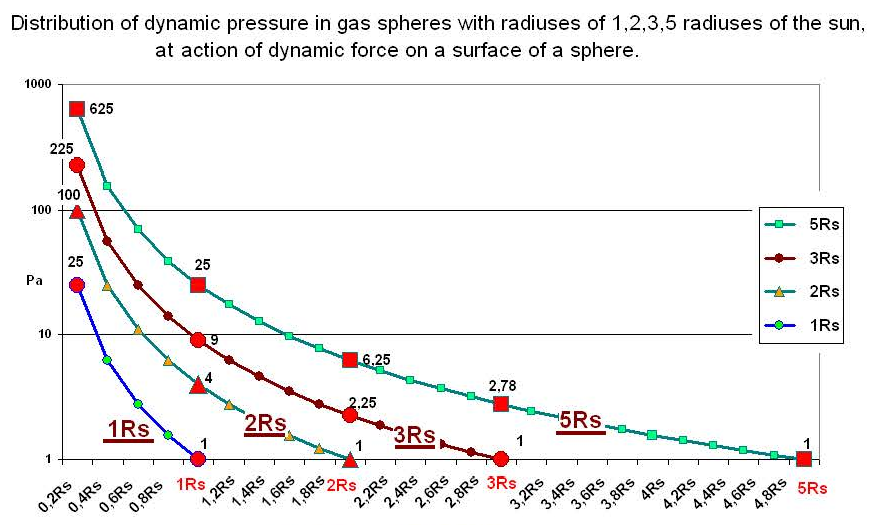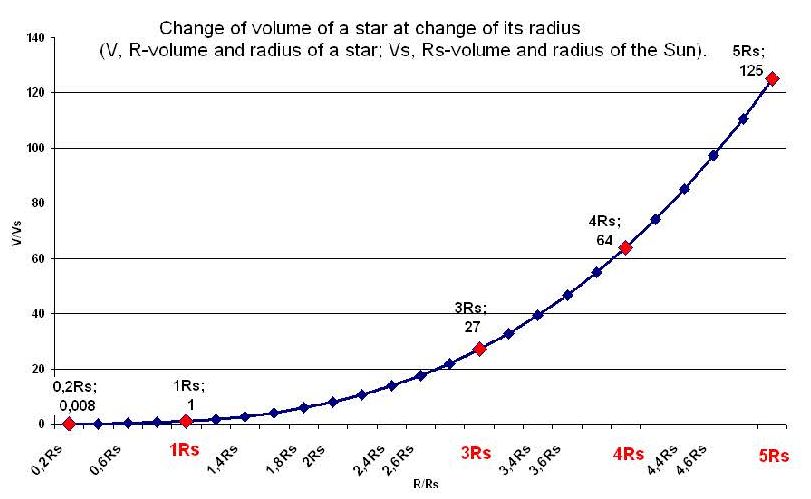(167), (18) Graph № G-2.5
The increase of the size of the star influences the rate of synthesis, not only by increasing the pressure in the star, but also by increasing the star itself, which allows to increase the number of kernels involved in the synthesis. This increase has a cubic dependence, as shown in the graph № G-2.6. Thus, increasing the radius of the star in 3 times, increases the volume of the star in 27 times, with increasing radius of the star in 4 times, the volume increased in 64 times. With an increase of 5 times the volume increased in 125 times.
Consequently, an increase in the size of the star increases the pressure of the compression of material in its interiors and the amount of this material, which leads to an increase in the rate of synthesis of kernels and an increase in the synthesis of heavier kernels. The increase in the rate of the synthesis in the star is reducing the time of its life, and increases the number of heavy nuclei, bringing their mass to «critical». For stars with large masses, the number of heavy kernels exceeds a «critical mass» that leads to the collapse of a star.
(168),(19) Graph №G-2.6
It is possible that the increase in pressure and volume of the star increases its size, shortens the lifetime of the star and cause the accumulation of heavy kernels of atoms in the core of the star (in the «white dwarf»). In the case of heavy stars, that leads to collapse.
From this analysis, we can conclude that the very shape of a star — a ball, is able to concentrate and intensify energy processes. This spherical design of stars works as a nuclear reactor, promotes the synthesis of virtually all elements of the periodic table, possibly in excess of the heavy elements beyond the aisles of the periodic table, and even those who cannot exist in Earth conditions.
On the other hand, while increasing the size of the star, the parameters ofgas-plasma mix are changing. In case of increase of parameters in gas-plasma mix at an increased allocation of energy in the star, a breakthrough of the «active zone» occurs, and part of the gas-plasma mix, «bleed» (thrown) into outer space through the «dark spots» of the star.
«Dark spots» on the surface of the star – it’s the organs of automatic thermodynamic control, and possibly control of nuclear processes in the star itself.
If in low-mass stars, the number of heavy kernels is small and not sufficient to start a chain reaction of fission and subsequent explosion, then the stars of medium and large masses have heavy and extra-heavy kernels in the «white dwarf» that are sufficient for a nuclear explosion.
If the power of the explosion of the «white dwarf» a medium-mass stars isn’t wide and as a result of this explosion only part of the mass of the star is released, then in the «white dwarf» of a star of large mass — the explosion of power is sufficient for all of the mass of the star to be ejected from the epicenter explosion. At the explosion site of the «the white dwarf», a star of large mass, remains a «black hole».



